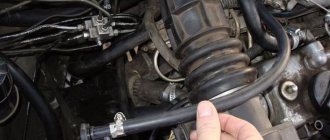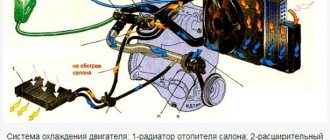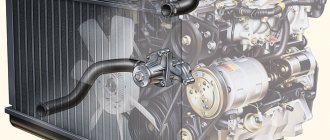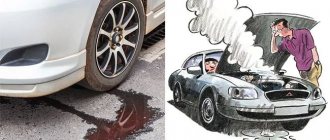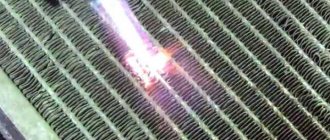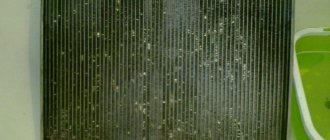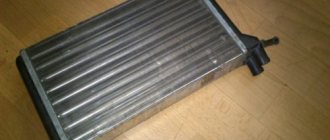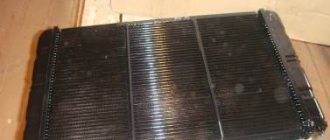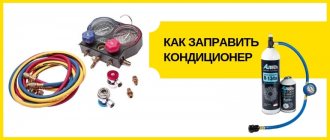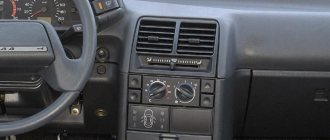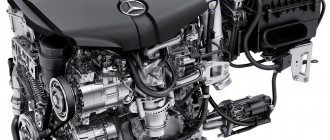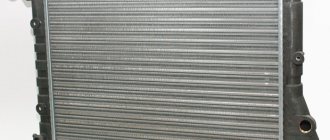No internal combustion engine can operate without proper cooling. There are many rubbing parts in the engine. If heat is not removed from them in a timely manner, the engine will simply jam. The radiator is a key element of the automotive cooling system. But it also needs regular washing. Let's figure out how to perform this procedure yourself.
- When should you flush the radiator?
- Various ways to flush the radiator without removing it
Washing with special means
- Washing with citric acid
Video: flushing the radiator with citric acid
Why does the radiator get dirty?
The reason for external contamination of the radiator is obvious: dirt gets on it directly from the road. The device is located in the engine compartment and does not have special protection. In the best case, a small shield can be installed under the radiator to prevent large stones and debris from getting into the fins of the device.
During operation, car radiators become dirty both inside and outside.
There are two reasons for internal pollution:
- dirt enters the cooling system from the outside. If there are cracks in the radiator hoses or in the radiator itself and the tightness of the system is broken, then its clogging is only a matter of time;
- The radiator becomes dirty due to poor antifreeze. It's no secret that finding high-quality antifreeze today is not so easy. The market is literally flooded with fakes. Antifreeze from well-known brands is especially often counterfeited.
Both dirty and fake antifreeze contain many foreign impurities. The radiator becomes very hot during operation. Sometimes antifreeze can even boil, and the impurities it contains form scale, which impedes the circulation of the coolant. Which leads to overheating of the motor.
What product can be used to clean the outside of a car radiator?
The radiator becomes clogged while using the car due to the fact that dust and debris fly into the car from the road one way or another. This part gets dirty much faster if the vehicle is driven on country roads or in areas where there is serious dust.
Insects can also get into the radiator, which later turn into a rather solid mass along with dust.
To clean the radiator without removing it, you can use ordinary water, which will clean its outer surface, but it is often not very easy to get to this part of the car.
To carry out high-quality cleaning, the radiator is often removed.
It even happens that ordinary cleaning of the outside with water turns out to be insufficient, since the dirt has settled so firmly that it cannot be removed from the surface using traditional methods.
To get rid of contamination, use a special product to clean the outside of the vehicle radiator.
As a rule, the heating radiator or air conditioner radiator is washed with running water, but in car washes this is done under quite high pressure. In this case, the operation must be performed as carefully as possible, since here it is possible to damage the honeycombs, which will simply cause a radiator leak. It will eventually lose its seal.
If salt sits on the radiator along with dirt, it should be removed from the surface of the part as quickly as possible. The fact is that the part is made of aluminum, and a saline solution can corrode it in just a few minutes. As a result, this will end in the same car radiator leak.
There are quite a lot of chemicals developed specifically so that chemical cleaning of the radiator can be done without removing this part.
Chemical products produced by
the following manufacturers are widely popular among drivers:
There are also universal cleaning agents on sale that can be used to clean not only dirt from the radiator of the car’s engine cooling system, but also from the entire engine.
The cost of such a substance can vary greatly - it depends on which company produced this product. In particular, the cost of one bottle, the volume of which will be about 250 ml, can reach a thousand rubles.
It is not advisable to purchase products that are too cheap, since inexpensive drugs may use too active substances, which can be as harmful as the pollution itself.
When should you flush the radiator?
Here are the signs that the cooling system is clogged:
- the engine quickly overheats even in the cold season, after which power failures appear, which are especially noticeable when trying to accelerate;
- The “coolant” light is constantly on on the dashboard, although there is antifreeze. This is another typical sign of a clogged radiator.
A constant "coolant" light indicates a clogged radiator.
To avoid the above problems, car manufacturers recommend flushing cooling systems at least once every 2 years.
Cleaning the radiator from the outside using special chemicals
On sale today you can find automotive chemicals for a wide variety of purposes, in particular, there are substances that allow you to quite effectively flush the cooling system the first time. However, it is worth saying that not every tool allows you to do this efficiently. There are substances that seriously disrupt the operation of both the engine and the car as a whole.
In this case, the rule works well - the cheaper the product, the worse it interacts with the radiator. It is best to use products for washing that are offered by world-famous companies producing automotive chemicals, which have also managed to gain a positive reputation.
In addition, you can find chemicals on sale that allow you to remove antifreeze leaks from the pipes or from the radiator. However, it should be used as carefully as possible, since it is quite viscous and its careless use leads to clogging of the tubes and thin hoses of the system.
Various ways to flush the radiator without removing it
You can flush the radiator with various liquids. And the only tool the car owner will need is an open-end wrench to unscrew the drain plug in the cooling system. The washing sequence itself differs only in the type of liquid used and consists of the following steps:
- The car engine starts, idles for 10 minutes, then turns off and allows to cool for 20 minutes.
- The drain plug is unscrewed. The old antifreeze is drained. In its place, flushing liquid is poured.
- The engine starts again and runs for 10–15 minutes.
- After the engine has cooled, the liquid is drained. Distilled water is poured in its place to remove any remaining detergent from the radiator.
- New antifreeze is poured into the system.
Washing with special means
In any auto parts store you can find special compounds for flushing automobile cooling systems. There are many of them, but the most popular among car enthusiasts are two liquids: LAVR and Motorresurs.
LAVR and Motorresurs compositions are in great demand due to their affordable prices
They have an optimal price-quality ratio. The washing sequence is shown above.
Washing with citric acid
Acid dissolves scale well. To create an acidic environment in the radiator, drivers successfully use a solution of citric acid in water.
Citric acid solution dissolves scale well in the radiator
Here are the main features of the process:
- the solution is prepared in the proportion of 1 kilogram of acid per 10-liter bucket of water. If the radiator is not too clogged, the acid content can be reduced to 700 grams;
- flushing is carried out according to the scheme given above, with the exception of one important point: the hot acid solution is not drained from the system immediately, but after about an hour. This allows you to achieve the best effect.
Video: flushing the radiator with citric acid
About rinsing with distilled water
Distilled water is very rarely used as a standalone detergent. This is done only when the radiator is slightly dirty. The reason is simple: water does not dissolve scale. It only flushes out the debris and dirt that has accumulated in the radiator. It is for this reason that distilled water is usually used only for flushing the radiator after the main detergent.
Coca-Cola Rinse
Coca-Cola has many unusual uses. These include flushing the radiator.
Coca-Cola has long been used by motorists to clean the radiator of thick layers of scale.
Once in the cooling system and warmed up, the drink quickly dissolves even a very thick layer of scale. But there are two important points:
- The operating time of the motor when washing should be no more than 3 minutes. Then the engine is turned off, and the drink is drained from the system only after half an hour;
- It is necessary to rinse the system with water after Coca-Cola very carefully. The drink contains a lot of sugar. And it can settle on the radiator pipes.
Swink › Blog › How to clean and flush a car radiator
If the engine can be compared to the heart of a car, then the cooling system is, perhaps, the endocrine glands.
The normal functioning of the cooling system is vital for the car, because failure to diagnose it in a timely manner or replace the necessary elements can result in serious problems with the engine. Based on this, for the normal operation of the cooling system, all you need is proper care and regular maintenance. - go to the store and buy a new radiator.
- Rinse and clean the radiator yourself.
It is not difficult to tidy up the engine cooling system yourself. The main thing before cleaning is to follow all safety rules: be sure to let the engine cool, firmly secure the hood, and wear waterproof gloves.
To check for contamination of the radiator, you need to drain all the antifreeze from it (if the liquid is clean, then there is no need to flush the radiator - there is no scale or rust in it) and pour clean water (preferably distilled) into the cooling system. Next, you need to start the car and let it run for 15-20 minutes, and then drain the water. This operation is carried out several times until clean water comes out of the drain taps. To enhance the efficiency of the operation, add a radiator cleaning agent (or caustic soda, or anti-scale agent) to the water. To do this, you don’t need a lot of special radiator flushing agent - just a few grams will be enough. Try not to overuse the amount of product, and follow the instructions on the packaging of the cleaning product - if the dosage is incorrect, you can damage the cooling system.
After flushing the radiator is completed, drain the water and the cleaning agent and rinse the radiator with clean water at least 5 times. Failure to properly remove any remaining radiator cleaner can lead to corrosion in the radiator. In order to prevent scale formation, various additives are added to antifreeze, which is based on ethylene glycol, which, thanks to their anti-corrosion and lubricating elements, prevent the formation of rust and various deposits in the radiator.
Very often, the result of overheating of a car engine is a radiator clogged on the outside (for example, with dust or poplar fluff). To solve this problem, the radiator is usually purged. For this radiator cleaning process, you can remove it and wash it on the floor using standard mini-washers or a jet of water under pressure. Try not to overdo it with pressure, as this can damage the radiator honeycomb. When flushing the radiator, it is undesirable to use chemical liquids based on aggressive acidic components. This can cause significant damage to the entire cooling system, radiator seals and hoses.
Source
Cleaning the external elements of the radiator
The best option is to flush the radiator with water under pressure. This can be done either in your garage (if you have a suitable compressor) or at the nearest car wash.
The best option for external radiator cleaning is flushing with water under pressure.
This cleaning method perfectly removes even the smallest contaminants, such as poplar fluff that has accumulated between the fins of the radiator. But you need to remember the following:
- the water pressure should not be too strong, since the radiator fins are very thin and easily deformed;
- There should be no aggressive chemical additives in the water. Rubber hoses with clamps and gaskets are attached to the radiator. Aggressive detergents can corrode all this, and the cooling system will lose its seal.
External car radiator cleaner
In the past, this unit could be cleaned at most car washes. To do this, it was first dismantled, cleaning the outer surfaces. Contaminants can adhere so firmly to the surface that it becomes impossible to wash them off with ordinary detergents. Cleaning with high-pressure water pressure may be the best solution, but strong water pressure can damage the internal honeycombs, and this will lead to depressurization.
It is better to spend a small amount of money and purchase a cleaner for cleaning the radiator outside. Auto chemicals contain concentrated active substances that successfully remove long-standing dirt, salt deposits, rust, oil, bitumen and other contaminants.
For effective external cleaning you will need the following tools and products:
The car enthusiast will need distilled water to prepare the washing solution. If the water is not purified from impurities, the active substances will quickly lose their properties. For all drivers cleaning cars, cleaning the outside of the car radiator will be more difficult in this case. And you will need to use more of the drug itself.
Car owners should take note of the following products if they need external cleaning:
How to avoid radiator contamination
It will not be possible to completely isolate the radiator from dirt. All a car enthusiast can do is to ensure that the radiator does not become clogged for as long as possible. This can be achieved in the following ways:
- Use only high-quality antifreeze recommended by the car manufacturer. The brand and type of coolant can be found in the machine's operating instructions. And you can purchase such antifreeze at specialized service centers that have the appropriate certificates;
- Carry a supply of distilled water with you. When the driver discovers that there is no antifreeze, he usually fills the radiator with whatever he can get his hands on. This is usually water from a river or stream. The amount of scale that forms in the radiator after such water is enormous. Therefore, you should always have distilled water on hand. It will allow you to get to the garage and extend the life of the radiator.
Keeping a supply of distilled water in the trunk will help avoid radiator clogging
So, anyone who wants their car to run properly must keep the radiator clean. No special skills are required to wash it. All you need is an open-end wrench and a suitable detergent.
Do-it-yourself car radiator cleaning
To perform such work, you can use soapy water and a regular wooden brush - this will be the easiest way. The honeycombs are cleaned from the outside in the direction of the internal combustion engine radiator mounts. After soaping is done, the unit is washed with a large amount of slightly heated water, which allows you to eliminate the remnants of detergents and dirt.
When cleaning the outside of a car's radiator, first remove it and pull it out from under the hood. Carrying out work in this way will give better results. It is worth spending a moderate amount of money and buying one of the specially designed chemical cleaning products at any auto store. They are diluted with warm water in the ratio indicated on the instructions for use.
Cleaning a car radiator
In order to thoroughly wash the radiator of the cooling system, you do not need to have specific and expensive equipment in the garage. It is quite possible to do the work with your own hands, without having many years of qualifications. Experts recommend carrying out this procedure at least once every 6-12 months - this will significantly extend the life of the node.
Few people like to drive their car with a faulty air conditioner. In the summer months, it refreshes and cools the air in the cabin; in the winter, it can serve as a source of heating. Cleaning the outside of the air conditioner radiator is carried out due to the clogging of its cells with coarse dust, insects, small stones and other debris.
Specialized car services perform such work using a special steam generator. Its role is to blow hot air over ribs made of soft metals. At home, you can wash the outside of the condenser, but this requires access to it. In order not to harm the plate bulkheads, cleaning is carried out with a small pressure of warm water, then the body is treated with a cleaning agent, and its residues are washed off again.
If external cleaning of the car radiator is not successful, you will have to resort to internal flushing. In cases where the damage has become too severe, the unit will need to be replaced. In most situations, mechanical cleaning can be done with your own hands and solve the overheating problem. At the same time, the thermostat and radiator cap are changed, and a thorough visual inspection of the condition of the hoses and pipes of the system is carried out.
Source
Causes of clogged engine cooling system
The working coolant has a tendency to “boil over”. Antifreeze, distilled water or antifreeze circulates in the system - these are working coolers, which are monitored by marks in the tank and periodically topped up. Overheating and boiling over leads to loss of coolant properties and the formation of deposits in pipelines and on the internal walls of the radiator.
You can learn how to replace the coolant from our specialist’s detailed material.
We recommend that you additionally read our expert’s article, in which he talks about how to remove air from the engine cooling system.
Possible causes of clogging:
- dust and mechanical inclusions;
- chemical deposits;
- formation of salts (when adding regular water);
- corrosion of the material of the internal elements of CO with precipitation into a clogging sediment.
Changes in color and smell are signals to replace the distillate. If the consistency changes, foreign particles appear, or a contaminated emulsion forms, you must immediately use means to flush the engine cooling system.
Lemon acid
The substance is capable of removing rust, since it contains acid . The working solution can be prepared as follows:
For 1 liter of ordinary water, take 2 tablespoons of acid if prevention or light cleaning is planned. If the part has not been washed for a long time, then take 10 tbsp per liter of water. spoons of substance. The water must have high acidity.
Algorithm of actions:
- The cooling system is drained of liquid.
- Pour in prepared water with acid.
- Start the engine, heat it up and leave it for a couple of hours.
- Drain the liquid. If it is cloudy, repeat the procedure.
- Rinse the system with plain water.
Video of flushing the cooling system with citric acid
To know exactly how to flush the radiator , watch the video on the Internet. This will help you flush the unit yourself. Citric acid is considered a good cheap remedy. Users recommend buying it not in bags, but by weight. It is recommended to take distilled water. Flushing the system with acid is easy and simple.
How to flush a cooling radiator with acetic acid
Vinegar is considered an effective and affordable system cleaner. For the procedure, take 1 bottle of vinegar and approximately 10 liters of water. Vinegar is diluted in water to obtain a 3% solution. It is poured into the cooling system. Next, start the engine, warming it up to operating temperature. After the fan automatically turns on, the engine is turned off. After this, the solution is drained. The engine cooling radiator can be additionally washed with soda solution.
How to flush the cooling system with lactic acid or whey
Cleaning the engine cooling system with whey is a gentle and longest-lasting method. After draining the old coolant, add filtered whey or lactic acid. Then we drive about 50 km by car. After this, the liquid is drained and the system is washed with clean water.
Do-it-yourself flushing of the engine cooling system using caustic soda
You can clean the radiator from dirt with caustic soda. This method is not used if the engine contains aluminum. Otherwise, such soda will react with it. This will cause motor damage. If you know for sure that there is no aluminum, you can wash the cooling system like this:
- Remove coolant.
- Prepare a working solution at the rate of 300 grams of caustic soda per 5 liters of water.
- Start the car.
- Leave the soda solution for 5 hours.
- Drain the liquid.
Caustic soda has a second hazard class. The hand must be gloved, otherwise the substance may corrode the skin. It is also recommended to use safety glasses when working.
Cleaning the cooling system with Fanta
Fanta drink is successfully used by car owners to clean radiators. It contains citric acid, which explains the cleansing effect. The duration of the procedure depends on how dirty the system is. Preventive cleaning consists of the fact that after pouring the forfeit inside, the engine is allowed to idle for about 40 minutes. To wash away old dirt, you need to drive a car for 2 days. Next, the used liquid is drained and the system is washed with distillate. After this, it is also drained and the part is washed with water. The clean system is filled with fresh antifreeze.
Useful tips
You can extend the time interval between cleaning the radiator from the inside if you fill it with high-quality coolant. Typically, it contains special additives that prevent sediment from depositing on the walls of the radiator. In addition, its composition itself prevents the formation or precipitation of sediment.
You should not purchase goods on the road. Despite their relative cheapness, they are most likely of poor quality, which, in turn, can lead not only to the formation of scale, but also to the destruction of the pipe material.
It is better to use the coolant recommended by the vehicle manufacturer.
Types and features of washing
Judging by the above, the importance of timely cleaning of the radiator is beyond doubt. The only question is how to properly clean a car radiator. There are two options here:
1. Internal flushing.
During internal flushing, the radiator is cleaned of deposits from the inside. In this case, you cannot do without special cleaning products, which will be discussed below. The algorithm of actions should be as follows:
- Open the hood and do other things while the power unit cools down to the required temperature;
- Drain the old coolant from the system. Finding the drain hole will not be difficult (as a rule, it is located at the bottom of the cooling device);
- Pour distilled water into the system (usually 5-7 liters is enough);
- Start the engine and let it run for about 15-20 minutes;
- Drain the previously filled distilled liquid;
- Follow the above procedure several times.
It is worth noting that using distilled liquid alone is not enough - it is worth adding a special cleaning agent to it. The effectiveness of flushing directly depends on a number of factors - the quality of the liquid used, its dosage and chemical composition. Before using the product, it is important to carefully read the instructions to avoid errors in use.
Thanks to internal cleaning of the radiator, you can remove traces of corrosion, antifreeze residues from the inside, and clean the system of scale and toxins. If flushing is performed correctly, the permeability of the tubes and the circulation of the entire system improves. If you use special compounds correctly, then you don’t have to worry about the integrity of rubber, plastic and metal elements.
After using the cleaning composition, experts recommend performing another rinse with distilled water. There are known cases when the composition remaining inside the radiator after cleaning led to the rapid destruction of the metal and the appearance of scale.
2. External flushing.
After completing the internal flushing, you can proceed to the next step - cleaning the radiator from the outside. This work helps to increase cooling efficiency by an average of 25-30 percent. Cleaning should be done in early spring - before the warm season, when the problem of overheating will be especially obvious.
The external cleaning process is carried out as follows:
- Remove the front bumper of the car. If the radiator can be removed without dismantling the bumper, then this is only a plus;
- Remove the radiator itself;
- Remove debris that is stuck to the surface using a thin tool and a brush. Be careful not to damage the delicate metal of the radiator;
- For greater efficiency, use the capabilities of a special mini-wash;
- Direct a stream of water at the surface and process until any dirt, dust or insects present on the surface are removed.
When cleaning, it is important not to overdo the pressure of the supplied fluid. Otherwise, there is a risk of deformation of thin radiator plates. Upon completion of work, the device should be dried naturally. Reinstall the product only when you are sure that it is free of dirt and dust.
To increase the efficiency of general cleaning, do not be lazy and buy new system tubes, because plaque also collects on them. After installing the radiator, fill it with coolant and run the engine for 25-30 minutes. This is enough to verify that the system is working and there are no leaks. If everything is normal, then the cleaning process can be considered complete.
Reasons for clogging
When using a car, small insects and sand get under the hood, so various debris gradually accumulates on the engine. Some accumulates in the radiator and mixes with the liquid. Gradually, the hoses become clogged, the unit ceases to function normally or even fails. Experienced drivers say that flushing the engine radiator should be done every 1 year/2 years.
For normal cleaning on all sides, it is better to remove the engine. However, this takes a long time. Therefore, car owners often think about how to flush the engine cooling radiator without removing it. Both store-bought products and traditional methods can help with this.
